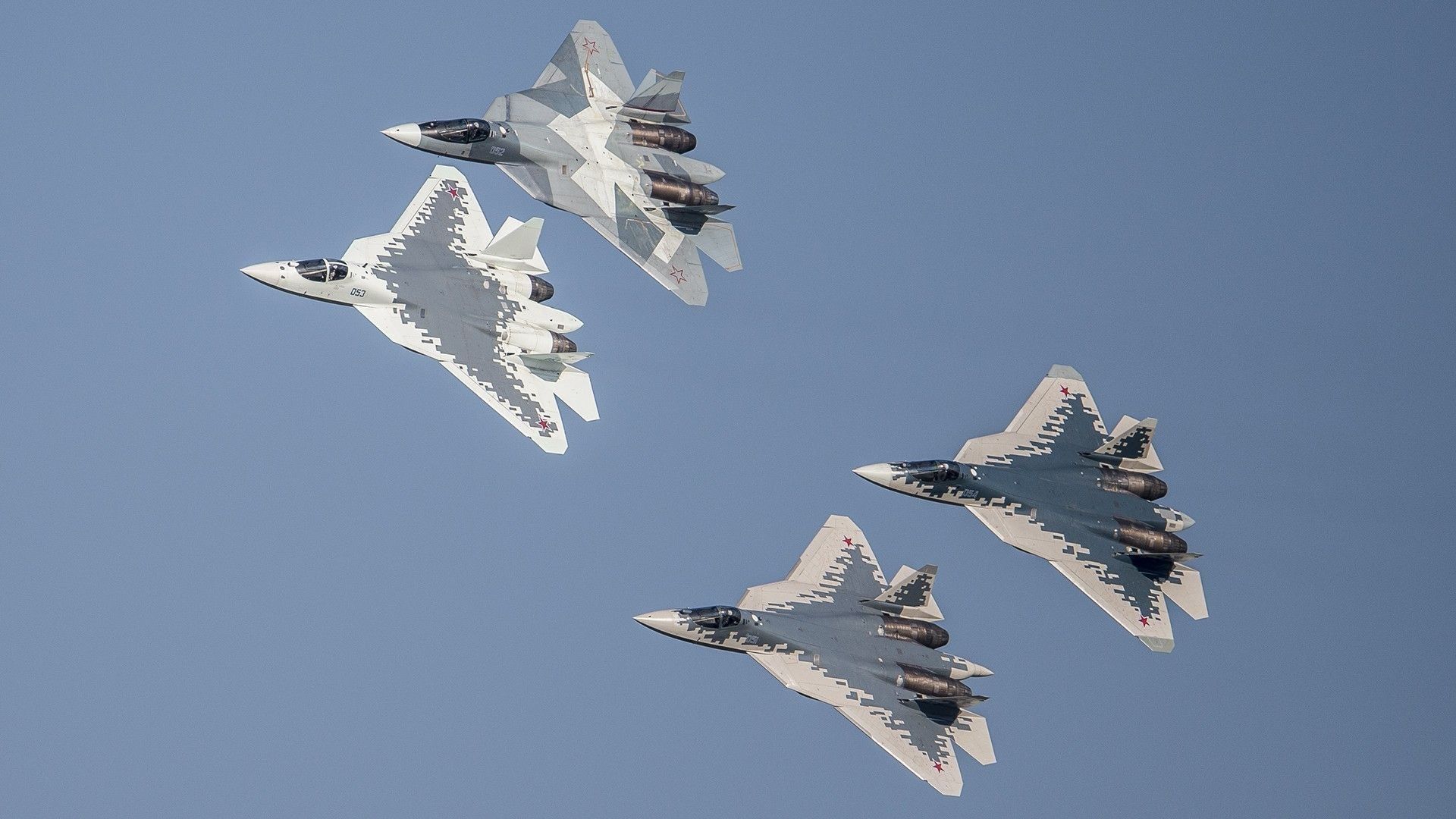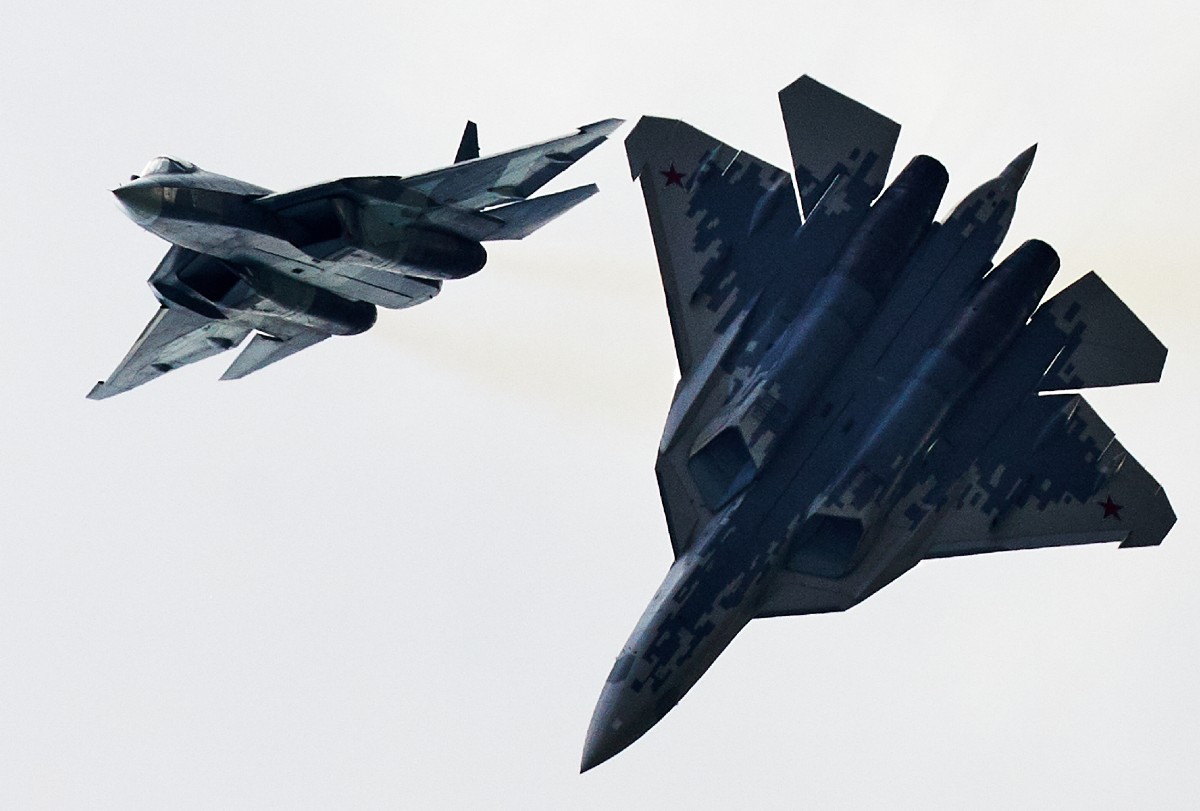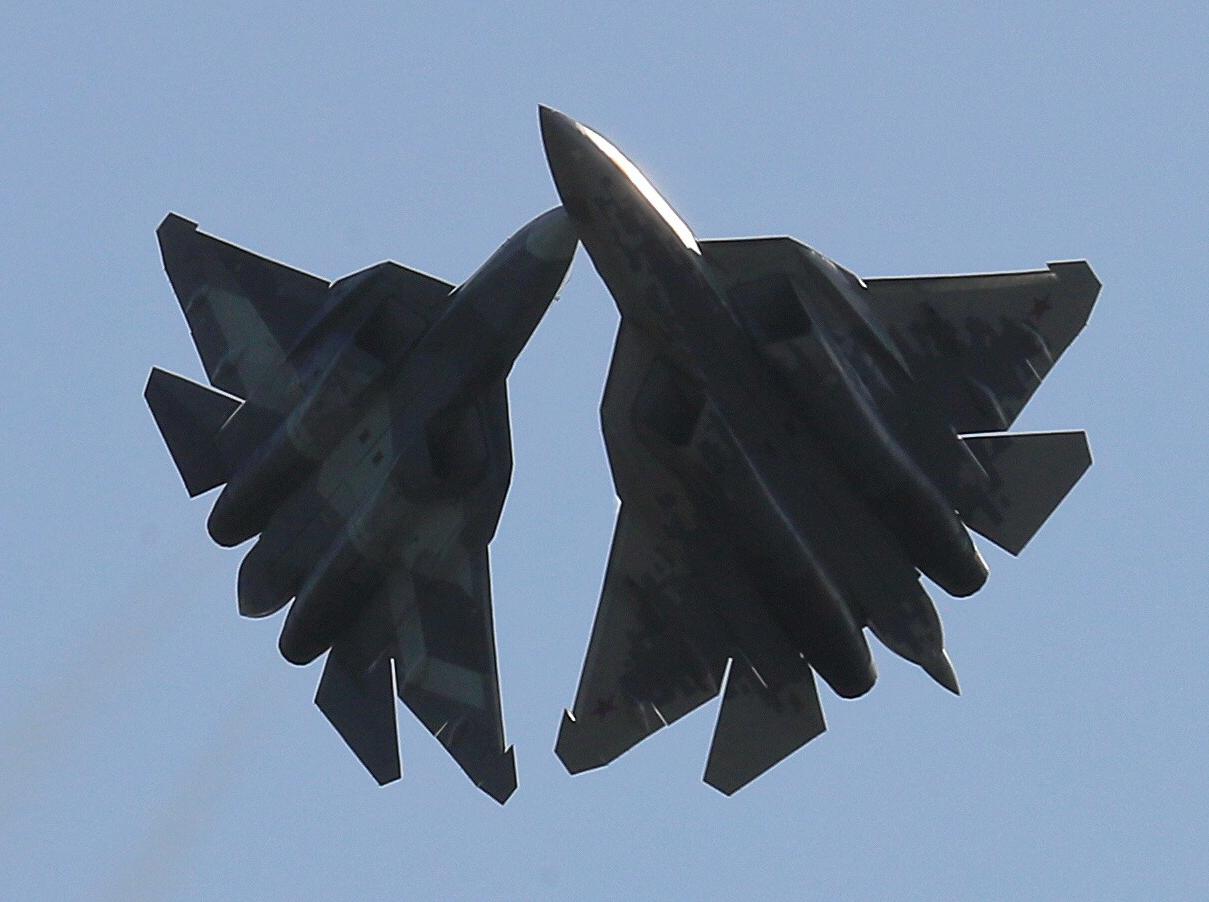The Su-57 And Hybrid Warfare - Navigating The New Battlefield
Explore the intricate world of the su-57, Russia's cutting-edge fifth-generation fighter jet, and its role in hybrid warfare. Delve into its advanced radar systems, cyber-resilient communication networks, and unmatched adaptability, dissecting how it counters multifaceted threats.
Oct 13, 20230 Shares19 Views

In the contemporary landscape of warfare, traditional battlefields have extended beyond physical boundaries into the realms of cyberspace, disinformation, and unconventional tactics. This shift has given rise to hybrid warfare, a complex and multifaceted form of conflict. The Sukhoi Su-57, Russia's cutting-edge fifth-generation fighter jet, stands at the forefront of this evolution, playing a pivotal role in the ever-changing dynamics of hybrid warfare.
Understanding Hybrid Warfare
In the complex landscape of contemporary warfare, the concept of hybrid warfare has emerged as a potent and multifaceted strategy. Hybrid warfare represents a blending of conventional military tactics with unconventional methods, such as cyber-attacks, disinformation campaigns, economic pressure, and political subversion. This approach seeks to exploit the weaknesses of an adversary by blurring the lines between war and peace, military and civilian, and traditional and irregular warfare.
Hybrid warfare leverages a combination of military force, non-state actors, and various forms of coercion to achieve strategic objectives. Unlike conventional warfare, which is characterized by clear battlefronts and defined rules of engagement, hybrid warfare operates in a gray zone, often making it challenging to attribute attacks to specific actors or entities. This ambiguity serves as a powerful tool, creating confusion and destabilizing the target nation's defenses.
One of the fundamental aspects of hybrid warfare is its focus on information warfare. Disinformation campaigns, propagated through social media, news outlets, and online platforms, are used to manipulate public opinion, create internal divisions, and erode trust in institutions. These campaigns are designed to exploit societal vulnerabilities, exploiting existing tensions and grievances to achieve political or military goals.
Another key element of hybrid warfare is the use of cyber-attacks to target critical infrastructure, disrupt communication networks, and compromise sensitive information. Cyber-attacks can paralyze essential services, create chaos, and weaken a nation's ability to respond effectively. These attacks often occur surreptitiously, making it difficult to detect and attribute them accurately.
Additionally, economic coercion, such as trade sanctions and financial pressure, is employed to weaken the target nation's economy and diminish its global influence. Hybrid warfare also involves proxy warfare, where non-state actors are funded, armed, and supported to carry out attacks, further complicating the attribution of responsibility.
Enhanced Situational Awareness - The Su-57's Tactical Edge
In the ever-evolving landscape of hybrid warfare, where adversaries exploit the cover of shadows and ambiguity, the Sukhoi Su-57 emerges as a beacon of technological prowess. At the heart of its effectiveness lies its unparalleled situational awareness capabilities, powered by advanced radar systems and sensors that redefine the boundaries of detection and identification.
Real-Time Threat Perception
In hybrid warfare scenarios, time is of the essence. The ability to discern friend from foe in the blink of an eye can be the difference between security and vulnerability. The Su-57's radar systems operate in real-time, providing instantaneous data processing and analysis. This rapid information assimilation allows military personnel to make split-second decisions, ensuring a proactive response to emerging threats.
Unmatched Precision And Range
The Su-57's radar capabilities extend far beyond the horizon, granting it an extensive operational range. This extended reach is pivotal in hybrid warfare, where adversaries employ diverse tactics across varied terrains. Whether patrolling vast maritime expanses, monitoring rugged mountain ranges, or navigating urban jungles, the Su-57's radar systems penetrate obstacles, offering a comprehensive view of the battlefield.
Countering Stealth And Evasion
Stealth technology, a hallmark of modern warfare, often conceals potential threats, making them elusive targets. The Su-57's radar systems are engineered to pierce the stealth shroud, detecting even the most advanced stealth aircraft and drones. By negating the cloak of invisibility, the Su-57 ensures that adversaries operating in the shadows are brought into the spotlight, minimizing the element of surprise and enhancing the effectiveness of counter-strategies.
Adaptability To Hybrid Threats
Hybrid warfare tactics are diverse and multifaceted. Adversaries employ unconventional methods, blending conventional military assets with cyber-attacks, disinformation campaigns, and proxy warfare. The Su-57's radar systems are not just sophisticated but also adaptive. They can differentiate between conventional and unconventional threats, allowing military forces to prioritize responses and allocate resources effectively in the face of hybrid challenges.
Securing National Interests
In an era where national security extends far beyond physical borders, the Su-57's enhanced situational awareness capabilities play a pivotal role in safeguarding a nation's interests. By providing a clear, real-time picture of the evolving threat landscape, the Su-57 empowers military commanders to devise nuanced and effective strategies, ensuring the protection of critical assets, infrastructure, and, most importantly, the lives of citizens.
Cyber-Resilient Communication Systems - Fortifying The Su-57's Digital Armor
In the age of hybrid warfare, where battlefields stretch beyond physical borders into the vast expanse of cyberspace, communication is not just a strategic advantage but a potential vulnerability. Adversaries, armed with sophisticated cyber-arsenals, exploit these vulnerabilities to disrupt communication networks, sow chaos, and gain unauthorized access to critical information. Recognizing the paramount importance of secure communication, the Sukhoi Su-57 integrates cutting-edge cyber-resilient communication systems, fortifying its digital armor against the relentless onslaught of cyber threats.
Advanced Encryption - Shielding Information From Prying Eyes
At the core of the Su-57's cyber-resilient communication systems lies advanced encryption technology. Military-grade encryption algorithms, designed to withstand even the most advanced decryption attempts, safeguard every piece of data transmitted through the aircraft's networks. These encryption protocols render intercepted information indecipherable, ensuring that sensitive military strategies, tactical maneuvers, and classified data remain secure from prying eyes.
Secure Communication Protocols: Building Virtual Fortresses
The Su-57's communication protocols are akin to building virtual fortresses around each piece of information. These protocols not only verify the identity of the sender and receiver but also establish secure channels that are impervious to interception or tampering. By employing secure communication protocols, the Su-57 creates a trusted network environment within which military commands, mission-critical data, and strategic directives are exchanged. This trust is the cornerstone of effective military coordination and decision-making in the face of hybrid threats.
Resilience Against Cyber Threats - Adapting To Technological Sophistication
Hybrid adversaries continually evolve their cyber tactics, employing increasingly sophisticated methods to breach communication barriers. The Su-57's cyber-resilient communication systems are not static defenses but adaptive shields. They are equipped with intrusion detection mechanisms and artificial intelligence algorithms capable of recognizing anomalous patterns indicative of cyber-attacks. In the face of a cyber onslaught, these systems autonomously adapt their defenses, repelling intrusions and ensuring the continuous flow of vital information.
Maintaining Operational Effectiveness - The Key To Mission Success
Operational effectiveness is the lifeblood of any military endeavor. In the context of hybrid warfare, where the landscape is as digital as it is physical, maintaining operational effectiveness hinges on secure and uninterrupted communication. The Su-57's cyber-resilient communication systems, by guaranteeing the integrity and confidentiality of transmitted information, play a pivotal role in preserving operational effectiveness. Uninterrupted communication ensures that pilots receive real-time intelligence, execute mission objectives, and respond to emerging threats swiftly and decisively.
Adaptable And Agile - The Su-57's Mastery Over Hybrid Warfare Challenges
In the ever-shifting landscape of hybrid warfare, where adversaries constantly morph their tactics to exploit vulnerabilities, adaptability and agility are paramount. The Sukhoi Su-57, an epitome of cutting-edge aviation engineering, rises to this challenge with unparalleled mastery. Its design, replete with advanced avionics and unmatched maneuverability, endows it with the ability to respond nimbly and effectively to an array of multifaceted threats, making it a truly versatile tool in the hybrid warfare toolkit.
Swift Response To Evolving Threats - A Tactical Advantage
Hybrid warfare is marked by its fluidity; threats can emerge from the skies, infiltrate through cyberspace, or strike through covert means. The Su-57's advanced avionics allow for real-time threat analysis and swift decision-making. Its sensors, coupled with state-of-the-art processing systems, detect changes in the battlefield environment, identifying both conventional and unconventional threats. This rapid threat assessment empowers Su-57 pilots to adjust their strategies on the fly, ensuring they stay one step ahead of the adversary.
Maneuverability Beyond Imagination - Defying Conventional Limits
The Su-57's maneuverability is nothing short of extraordinary. With vectored thrust engines and aerodynamic innovations, it can execute acrobatic maneuvers that defy the laws of physics. This exceptional agility is a game-changer in hybrid warfare scenarios. When faced with threats from enemy aircraft, the Su-57 can outmaneuver and outpace adversaries, gaining a crucial advantage in aerial combat. Moreover, in cyber warfare, its ability to swiftly change communication frequencies and routes ensures that adversaries find it nearly impossible to intercept or disrupt crucial communications.
Versatility In Countering Diverse Threats - A Multidimensional Approach
Hybrid warfare encompasses a spectrum of threats, from conventional military actions to cyber-espionage and disinformation campaigns. The Su-57's adaptability shines brightly in this diverse threat landscape. Against traditional fighter jets, it can engage in dogfights, leveraging its speed and agility. In response to cyber-attacks, it can employ advanced electronic countermeasures, disrupting enemy attempts to breach its systems. When combating disinformation campaigns, its secure communication systems enable precise dissemination of accurate information, countering propaganda effectively.
Continuous Tactical Evolution - Learning From Experience
One of the Su-57's greatest strengths is its ability to learn and evolve. After every encounter, every skirmish, the data gathered and lessons learned are integrated back into its systems. This continuous feedback loop ensures that the Su-57 becomes more adept at countering hybrid threats with every engagement. It adapts not just to the current threat landscape but also anticipates future challenges, making it an enduring and forward-thinking asset in the face of ever-changing hybrid tactics.
Strategic Deterrence And Hybrid Warfare
In the intricate chessboard of international relations, strategic deterrence stands as a linchpin of stability. As hybrid warfare redefines the rules of engagement, the Sukhoi Su-57 emerges as a formidable deterrent, wielding not just military might but also showcasing Russia’s technological prowess and unwavering commitment to national security. Its mere presence in contested regions acts as a sentinel, dissuading adversaries from venturing into the realm of hybrid tactics, thereby maintaining stability and deterring potential aggression.
A Symbol Of Technological Supremacy:
The Su-57, with its cutting-edge technology and advanced capabilities, symbolizes Russia’s mastery in the field of military aviation. Its stealth features, unmatched maneuverability, and cyber-resilient communication systems exemplify the pinnacle of aerospace engineering. The aircraft becomes a tangible representation of Russia's dedication to innovation and its ability to stay ahead in the technological arms race. This symbolism is not lost on adversaries, who recognize the futility of challenging a nation armed with such advanced military assets.
The Power Of Psychological Deterrence:
Hybrid warfare is as much about psychology as it is about physical capabilities. The Su-57's presence exudes confidence and resolve. Potential aggressors are acutely aware of the risks associated with provoking a nation equipped with a fleet of Su-57s. The psychological impact of facing such a formidable adversary dissuades hostile actions. The knowledge that any attempt to escalate hybrid tactics might trigger a response from these cutting-edge aircraft acts as a powerful deterrent, fostering a cautious approach among potential adversaries.
Countering Ambiguity With Certainty:
Hybrid tactics often rely on ambiguity and misinformation. The Su-57, as a clear and tangible asset, counters this ambiguity with certainty. Its presence in contested regions dispels doubts about a nation's defense capabilities. Adversaries are met with an undeniable truth: a nation with Su-57s is prepared, vigilant, and more than capable of defending its interests. This clarity leaves no room for speculation, establishing clear boundaries and dissuading any attempts to test the nation's resolve.
Maintaining Regional Stability:
In regions prone to hybrid threats, the Su-57 acts as a stabilizing force. By deterring potential aggressors, it prevents the escalation of conflicts and maintains a delicate equilibrium. The stability provided by the Su-57's presence allows diplomatic efforts to flourish, fostering dialogue and reducing the likelihood of full-scale military confrontations. In this way, the Su-57 not only deters aggression but also facilitates peaceful resolutions, enhancing regional stability and security.
A Testament To National Unity:
The Su-57 also serves as a testament to a nation's unity and resolve. Its development and deployment signify a collective effort, showcasing the synergy between scientific innovation, military expertise, and national determination. Adversaries recognize that an attack on a nation equipped with such advanced weaponry would not only be met with a military response but also galvanize the nation, fostering a sense of unity that strengthens its resolve in the face of external threats.
Su-57 - FAQs
Has Ukraine Shot Down Su-57?
No, there is no credible evidence or verified reports to suggest that Ukraine has shot down a Su-57 aircraft during the war. It's essential to rely on accurate and official sources for such information, avoiding sensationalism and unverified claims.
Is The Su-57 Better Than The F-22?
The Su-57 and the F-22, both aircraft are advanced fifth-generation fighters, but their superiority depends on specific mission requirements and operational contexts. Each aircraft has unique features, and the determination of which is "better" would require a detailed analysis of their respective capabilities, which might vary depending on the specific mission or scenario.
How Many Su-57 Does Russia Have?
There is a limited number of operational Su-57 aircraft, with public reports suggesting the current count ranges between four and 15. Russia's TASS news agency has revealed plans for the country to acquire 76 additional Su-57s over the next five years.
Conclusion
In the era of hybrid warfare, the Su-57 emerges as a beacon of innovation and resilience. Its integration of advanced technology, cyber-resilient communication systems, and adaptability positions it as a key player in safeguarding national security. As hybrid warfare continues to evolve, the Su-57 stands ready, defending not just the skies but also the very fabric of a nation's security against multifaceted threats.
Jump to
Latest Articles
Popular Articles


